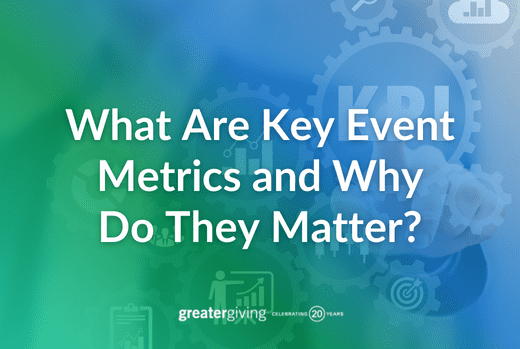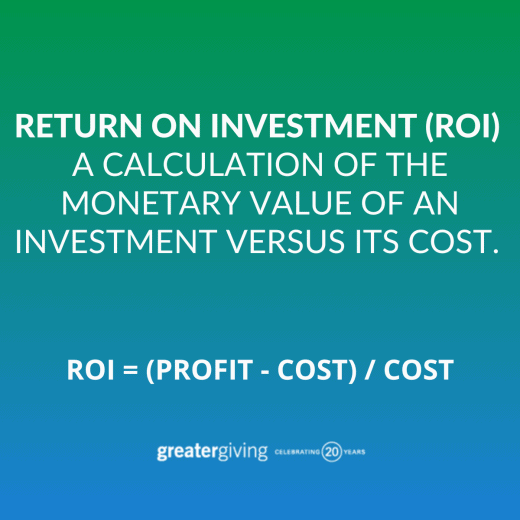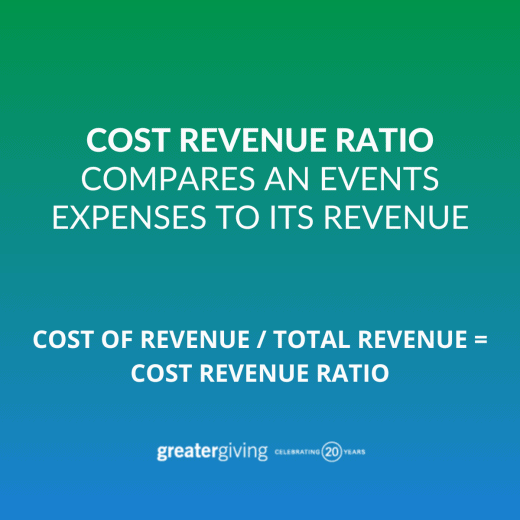
These key event metrics quantify the success of your events, and can show you how to improve them.
Key performance indicators (KPIs) are measures of how much money your fundraising events are raising, how your audience is growing, and which parts of your event are the most successful. Tracking these key event metrics can deliver critical insight into what you’re doing well, and where your events need improvement.
But getting high-quality event analytics requires high-quality, accurate numbers—which means carefully tracking data along the way. Getting clean, accurate data makes for clean, accurate KPIs, and setting yourself up for future success!
So what are those metrics, and what data do you need to track to analyze them?
 Fundraising ROI (Return on Investment)
Fundraising ROI (Return on Investment)
One key piece of information about any fundraising event is how much money was put in, and how much money it raised in return. You may know how much a fundraiser brought in, but did it deliver given the cost and investment? What was your profit margin?
Calculating ROI can tell you how worthwhile each event is—and other key event metrics can tell you how to improve it in the future.
Determining your ROI begins with tracking expenditures carefully while planning and executing your fundraising event. Once you know all of the costs associated with producing an event, you can divide your overall net revenue by those expenses.
Key Event Metric examples to help you track your own ROI.
Let’s say that your event raised a total of $500,000, but you put $144,000 into producing it in the form of venue rental, catering, entertainment, production, auctioneers, and technology. To find your ROI, you want to find your Net Revenue (Profit minus cost) divided by the cost.
In this example: ( $500,000 – $144,000 / $144,000 ) x 100 =247%
The resulting number is a percentage that will tell you how much money you made back on every dollar spent. In our example, the event had a 347% ROI, or a return of 3.47 dollars for every dollar spent producing it.
Determining your ROI accurately requires keeping track of every expenditure and every dollar raised.
Cost-to-Revenue Ratio 
A cost-to-revenue ratio is a slightly different measurement than ROI that can tell you how much profit your event made versus the costs sunk into it, helping you determine whether the event overall showed a profit or a loss.
To get your cost-to-revenue ratio, divide the overall cost of the event by the revenue generated, and once again multiply by 100. In the case of our previous example:
($144,000 / $500,000 ) x 100 = 28.8%
This tells us that for every $28.80 spent, you made $100. The lower the ratio, the more effective your spending is.
Cost-to-revenue ratio tracks how far your spending goes year over year, so even if you spend more next year but raise more as a result, your ratio will show the overall improvement.
Important Event Metrics to Track
So which individual key event metrics contribute to the overall revenue of an event? How do you show year-over-year changes? And how do you determine where you need to improve?
Sponsorship Dollars
Tracking how much your event made in sponsorships each year can show you which sponsorship solicitation strategies are effective, and which aren’t.
Comparing the number of participating sponsors each year to overall sponsorship dollars raised can give you a good idea of how much the average sponsor is contributing. Raising the number of sponsors each year, as well as the number of dollars contributed by each sponsor, can contribute immensely to the overall revenue and ROI of your event.
To find your average sponsorship contribution, simply divide total sponsorship dollars by the number of sponsors.
Event Attendance Rate
This is one of the key event metrics can show you the overall effectiveness of your marketing and communication strategies with attendees.
The event attendance rate is produced by dividing the number of actual attendees by the number of total invited attendees, and then multiplying the result by 100.
If you invited 500 people, and 350 attended, then you’ll perform the following calculation:
(350 / 500) x 100 = 70%
This means that 70% of all invited guests actually attended the event. Raising your event attendance KPI means narrowing in on your event’s specific audience, and building a reputation for your event that guests can’t turn down. And measuring this key performance indicator across years can tell you which of your marketing and communication methods work best for driving potential guests to commit.
Attendance Growth
In the same vein, as your event grows, so should your guest list. Showing your attendance growth requires comparing attendance rates across years—60% attendance rate last year and 70% this year shows a growth rate of 10% between both events.
Contribution Areas
Even more important are the individual fundraising components of your event, and how each of them is performing so you can better hone your efforts and trim any approaches that aren’t working.
Start out by tracking these important numbers:
Silent Auction
Averaging your silent auction sales can give you an idea of how much the effort put into soliciting an auction item will raise for your nonprofit.
To find the average item sale price, simply divide your total silent auction revenue by the number of items put up for sale. For example, let’s say you had 155 items in your silent auction, which generated $60,000 in overall auction sales. Your calculation would look like this:
$60,000 / 155 items = $387 average sale price
The higher this number, the more your solicitation efforts are producing in terms of funds raised. Getting bigger, more exclusive and more desirable items can raise your average silent auction sale significantly!
You may also want to take a look at the percent to value for certain auction items to determine which items are worth trying to get for your next event. To do this divide the amount the item sold for divided by the value of the item.
Live Auction
Averaging your live auction sales works the same way as silent auction sales, but generally produces a much higher number, as we typically put our big ticket items in the live auction.
The success of a live auction depends immensely on the atmosphere of your event, the energy in the room, and the emotional power of the appeal. Professional benefit auctioneers also work hard to drive those live auction bids as high as possible.
Average Gift Size
This number is incredibly helpful for determining how much your average donor is giving, and can help measure your efforts to solicit bigger gifts from each donor.
To calculate the average gift size, simply divide the total raised from donations with the number of donors who contributed. Then you can compare this key performance indicator across multiple years to see how gift size has changed—and what you can do to continue growing your gifts.
Fund-A-Need Donation Ratio
This event metric is wonderful for determining how well your fundraising efforts are working overall, and where that atmosphere of giving in the ballroom might need some work.
To find the donation ratio during the Fund-A-Need, simply divide the number of donors who participated in the Fund-A-Need with the total number of attendees at your event. Let’s say that 500 people attended your event, but only 270 of them donated in the Fund-A-Need. (The size of the gift doesn’t matter for this equation!)
270 / 500 = 0.54, or 54%.
That means more than half of your event attendees contributed in the Fund-A-Need. This is one of the key event metrics to improve year-over-year as you hone in on what makes your attendees feel generous, and how your Fund-A-Need can better drive giving.
Getting Feedback on Your Event Metrics
Not sure how to find out what needs improving, or how to drive up your fundraising event KPIs?
Consider sending out a survey to your event attendees! They can tell you best what you can do differently to drive the spirit of giving during your event, or what might be missing for them from the overall fundraiser experience.
There are clear benefits to using a fundraiser software to track and measure key event metrics. You can track your data easily and more accurately to find opportunities and target your efforts so they benefit your goals.
As you start the planning process for your next successful fundraising event, be sure to pay attention to these numbers. Then use this data to make adjustments and additional improvements as needed across all strategy areas.
